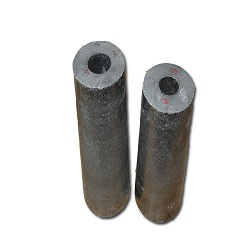Selection requirements of refractories for refining ladle slag line
In the past, magnesia-chrome bricks and high alumina bricks were mainly used for refining ladles as lining refractories for slag line parts and low-corrosion areas respectively. Considering the requirements of environmental protection, except for the vacuum deoxidized ladle, all chromium-free have been realized, and ladle magnesia carbon brick or magnesia-carbon-calcium brick is used as the refractory material for the lining of the slag line, and the molten steel is vacuum refined (Including refined low-carbon and super-carbon steel) The lining of the ladle slag line is made of low-carbon magnesia-carbon bricks. The choice of ladle magnesia carbon bricks or magnesia-carbon-calcium bricks for the refining ladle slag line mainly depends on the refined steel type, slag characteristics and operating conditions. The advantages of magnesia-carbon-calcium brick: The research results show that: in the CaO-SiO2 system slag (low alkalinity slag), the magnesia-c...




